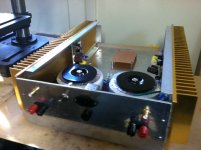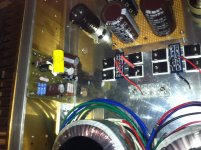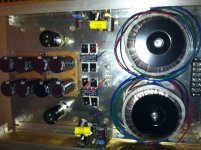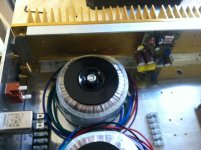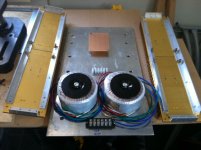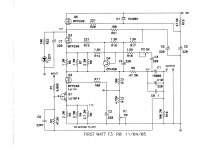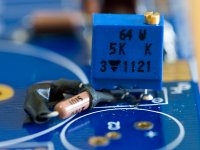No,
at normal 46V DC the F3 has a power consumption/dissipation of 160W, 80W each channel.
At 70V you will have a bias at 33 V instead of normal 21 V, so you will get arround 250 W, 125 W each channel power consumption and your Heatsink will get pretty hot.
Take a look at ZEN v4 on the firstwatt artikles, there are some variations with up to 64 DC and 2A bias current - HTH
The guy who sold me the boards has had only 3 sets. One set he will build his own F3 and the others are mine now.
I plan to build an fully active system. If I stay with the F3 I'll build the second F3 for mids and treble - if not you can have both, the 2nd set of boards and the ready built F3, with the right voltage btw 😉
cheers
at normal 46V DC the F3 has a power consumption/dissipation of 160W, 80W each channel.
At 70V you will have a bias at 33 V instead of normal 21 V, so you will get arround 250 W, 125 W each channel power consumption and your Heatsink will get pretty hot.
Take a look at ZEN v4 on the firstwatt artikles, there are some variations with up to 64 DC and 2A bias current - HTH
The guy who sold me the boards has had only 3 sets. One set he will build his own F3 and the others are mine now.
I plan to build an fully active system. If I stay with the F3 I'll build the second F3 for mids and treble - if not you can have both, the 2nd set of boards and the ready built F3, with the right voltage btw 😉
cheers
Last edited:
I agree with your calculation. I was calculating per channel actually.
Since I have two heatsinks per monoblock at .33c/w each that means around .17c/w per channel. That would put it around +22 degrees from room temp so around 40-50 centigrade degrees depending on the season of course.
Since I have two heatsinks per monoblock at .33c/w each that means around .17c/w per channel. That would put it around +22 degrees from room temp so around 40-50 centigrade degrees depending on the season of course.
By the way I used to have Naim 110, 180, 250 until I started on the diy route. I still have the 42/110 which I keep for sentimental reasons since it was my first "hi-end" amp when I was till a student more than 30 years ago.
Hi,
same carrier as mine, currently I use Naim NAC 72 + HiCap and NAP 250, both more or less modified in the last years, from a classical Linn-Naim-Linn combo...
The F3 sounds quite detaild and lets me dive deep into music, but I'm afraid it is far away from the power and punch of the NAP 250 🙁
Due to the lower gain of the F3 of 12 dB instead of 26 of the Naim it is hard to compare.
here is a pic of my work:

it is only a 2HE case but coupling inner and outer heatsinks works well.
Temparature is arround 45°C at the inner HS, outer 3-4 K less - sometimes it is not too bad to live in cold germany😉
In June I will have a meeting with other diy guys where the F3 will be part of a _shootout_ of different amps combined with different speaker concepts
cheers
same carrier as mine, currently I use Naim NAC 72 + HiCap and NAP 250, both more or less modified in the last years, from a classical Linn-Naim-Linn combo...
The F3 sounds quite detaild and lets me dive deep into music, but I'm afraid it is far away from the power and punch of the NAP 250 🙁
Due to the lower gain of the F3 of 12 dB instead of 26 of the Naim it is hard to compare.
here is a pic of my work:
it is only a 2HE case but coupling inner and outer heatsinks works well.
Temparature is arround 45°C at the inner HS, outer 3-4 K less - sometimes it is not too bad to live in cold germany😉
In June I will have a meeting with other diy guys where the F3 will be part of a _shootout_ of different amps combined with different speaker concepts
cheers
Obviously the F3 will work best with very efficient speakers. I went the SET tube way some years ago and I realized that you cannot run a set amp near its max otherwise you lose its delicacy. I think the same is true of the F3.
So I decided to invest in efficient speakers 98db made in Germany by Bastanis (I had some Linn which I was not happy with then some excellent Zingali 90db which were still not efficient enough for my 12W SET amp). I am very happy with the Bastanis Prometheus kit which is extremely good value for money. I have compared it in Athens as member of the Athens Audiophile Club with members speakers costing in the five figure range and I was not at all jealous.
So I decided to invest in efficient speakers 98db made in Germany by Bastanis (I had some Linn which I was not happy with then some excellent Zingali 90db which were still not efficient enough for my 12W SET amp). I am very happy with the Bastanis Prometheus kit which is extremely good value for money. I have compared it in Athens as member of the Athens Audiophile Club with members speakers costing in the five figure range and I was not at all jealous.
Obviously the F3 will work best with very efficient speakers. I went the SET tube way some years ago and I realized that you cannot run a set amp near its max otherwise you lose its delicacy. I think the same is true of the F3.
So I decided to invest in efficient speakers 98db made in Germany by Bastanis (I had some Linn which I was not happy with then some excellent Zingali 90db which were still not efficient enough for my 12W SET amp). I am very happy with the Bastanis Prometheus kit which is extremely good value for money. I have compared it in Athens as member of the Athens Audiophile Club with members speakers costing in the five figure range and I was not at all jealous.
oh yes, I know the Bastanis. I heard them at a small privat exhibition with a friend who has build something similar with 2 drivers in d'appolito arrangement; it is not really d'Appolito design, because the split between mid/Treb is too high.
In some cases I like those speakers, but it is not my cup of tea in any way, so I'll try to go a way between these concepts with high efficiency as possible and normal 3 ways - a painful splits may be...
I guess an efficiency of 95dB is possible to achieve and the both F3 will go from arround 100Hz and 1kHz for mid and trebble - we will see
cheers
Thorsten
Hi Folks,
I've a question to the F3 old hands out there:
After the second intensive listening session I have the feeling that the F3 becomes better and better. After I noticed more details from the beginning there is also a better texture now, especially at female voices and cymbals.
Does the F3 need a longer burn in time?
The sound like cell phone ringtone in the first 10 min and dull sound in the next 30 min is normal due to warm up?
thanks & cheers
I've a question to the F3 old hands out there:
After the second intensive listening session I have the feeling that the F3 becomes better and better. After I noticed more details from the beginning there is also a better texture now, especially at female voices and cymbals.
Does the F3 need a longer burn in time?
The sound like cell phone ringtone in the first 10 min and dull sound in the next 30 min is normal due to warm up?
thanks & cheers
My experience with ALEPH 5 and Aleph-x which have similarities is that some warm up and burn in is needed but not as dramatic as you suggest.
It depends on the caps you use, particularly the C1 o/p cap and the C3 that "feeds" the top half of the cct.
Not sure about Panasonics and others but Silmics, Nichicon FGs, Epcos Sikorels, Mundorf HAs, take about 5 - 7 days and Nichi KZ, Rifa, BHC SlitFoils, etc take about 10 days, running continuously into rated load - BlackGates seem to take forever, and didn't sound exceptionally good as either C10 or C3 but this is just my system sound - others may be quite different.
After about 300hours it seems the mids open up a bit more - the bass is the main difficulty and it varies enormously.
... my 2 cents
Not sure about Panasonics and others but Silmics, Nichicon FGs, Epcos Sikorels, Mundorf HAs, take about 5 - 7 days and Nichi KZ, Rifa, BHC SlitFoils, etc take about 10 days, running continuously into rated load - BlackGates seem to take forever, and didn't sound exceptionally good as either C10 or C3 but this is just my system sound - others may be quite different.
After about 300hours it seems the mids open up a bit more - the bass is the main difficulty and it varies enormously.
... my 2 cents
thanks for reply,
C1 is splittet for bi-wi in 220µF || 470µF (both Elna Silmic II RFS) for mid and trebble and 4 X 2,200µF Pana FC for fullrange or bass. (Currently 8 ohms 3 way Linn speakers 90 dB)
Currently the F3 runs at fullrange with the panas for easier compare to existing NAP250
Also C5, C6, and C7 is Pana FC due to higher voltage range and all others are Elna Silmic II RFS
James, you also use PHB manganins for the power res? Did you mounted a heat sink? Mine are running quite hot (R5,6,7 = 3 X 1R2 || and R2, 3, 4 = 3 X 2R2 ||, each 3W)
tia & cheers
C1 is splittet for bi-wi in 220µF || 470µF (both Elna Silmic II RFS) for mid and trebble and 4 X 2,200µF Pana FC for fullrange or bass. (Currently 8 ohms 3 way Linn speakers 90 dB)
Currently the F3 runs at fullrange with the panas for easier compare to existing NAP250
Also C5, C6, and C7 is Pana FC due to higher voltage range and all others are Elna Silmic II RFS
James, you also use PHB manganins for the power res? Did you mounted a heat sink? Mine are running quite hot (R5,6,7 = 3 X 1R2 || and R2, 3, 4 = 3 X 2R2 ||, each 3W)
tia & cheers
Actually, I just used single power resistors for R5,6,7 and R2,3,4 and also R9 - they seem quite happy there - quite hot, as you can imagine, but no problems - I'd better find the thermo and measure them, I suppose - dont think Hannes (ha) would be happy with me if I burnt them, as he went to a lot of trouble to get them for me! I gave up on Conrads ever getting anything delivered outside of Europe!
The amp has an open mesh lid (not often used) so maybe this is enough to keep them all functioning okay - used Manganin handmade resistors all thru the signal path - maybe change them to Neohms as better sound, IMO - made a big effort on the capacitors with bipasses and such - made the amp "faster" and "cleaner" without losing that F3 magic but not "clean and tidy" anymore!
Thanks for asking ... James
The amp has an open mesh lid (not often used) so maybe this is enough to keep them all functioning okay - used Manganin handmade resistors all thru the signal path - maybe change them to Neohms as better sound, IMO - made a big effort on the capacitors with bipasses and such - made the amp "faster" and "cleaner" without losing that F3 magic but not "clean and tidy" anymore!
Thanks for asking ... James
Hi James,
I wouldn't have any problems to send a package to australia, don't hesitate to ask me buying something from conrad for you, payment also wouldn't be a problem if you have also a paypal account.
I often read about bypassing Elnas is not a good idea. What will be a good choice to bypass, 1 µF film KP from Janzen or AmpOhm or even Mundorf M-Cap Supreme?
Has anyone tried to run the F3 with lower voltage? I have a 2 X 27 V high quality r-core transformer here on stock, to use the separate windings for each channel for real dual mono.
What has to be changened of the resistors and what will be the consequences beside of lower output power?
thanks & cheers
Thorsten
I wouldn't have any problems to send a package to australia, don't hesitate to ask me buying something from conrad for you, payment also wouldn't be a problem if you have also a paypal account.
I often read about bypassing Elnas is not a good idea. What will be a good choice to bypass, 1 µF film KP from Janzen or AmpOhm or even Mundorf M-Cap Supreme?
Has anyone tried to run the F3 with lower voltage? I have a 2 X 27 V high quality r-core transformer here on stock, to use the separate windings for each channel for real dual mono.
What has to be changened of the resistors and what will be the consequences beside of lower output power?
thanks & cheers
Thorsten
Thanks for the offer and I'll certainly keep it in mind
I can't add much about bipassing the Silmics but I vaguely remember them behaving themselves better with film caps that weren't low impedance but I ended u changing them all out for "faster" cap combinations
So C5, 6 &7 are NichiconKZs with 44uF bipass (Russian K73-16) - the rest get a bit weird with C4 = 470u (Rifa peg124) // 66uF (K73) C2 = 220u (Rifa peg124) // 44uF(K73) // 1uF (Jantzen superiorZ) and C3 = 60uF AuriCap C1 = NichiconKG 10,000 // C8 = 220uNichiKZ // 200uF (K73-16) C10 = 15nF mkt1837
On the power supply, the second cap of the R-C-R-C (Siemens 22,000 Sikorel) has // 1000uF Nichi kz // with 47uRifa peg124 + 1.8R snubber added - tricky set, this one!
I remember that I did most of this after completing Patrick's (EUVL) DAO headphone power amp and it was so much 'faster' and 'cleaner' that I was curious to see if something similar could be done with the F3's active current source (the C3 limitations) and so the project developed - the Manganin power resistors were the 'icing on the cake' and then the 200uF on the o/p cap made quite a bit of difference too.
I didn't get much advantage driving the Coral beta8 via seperate o/p caps (alternative C1's) so went back to the conventional series passive Xover - eventually the F5 will drive the bass via electronic Xover but haven't got around to it yet.
'hope this is of some use ... James
There's a thread called "Choky Susy F3 ..." that carried on the ZenMod version of balanced F3 that operated on +30 volt rail so that will give to a starting point - John Inlaw (Inlawsound, this site) did a lot of work on choke loading the balanced F3 and would be full of info that could easily be applied to your requirements.
I can't add much about bipassing the Silmics but I vaguely remember them behaving themselves better with film caps that weren't low impedance but I ended u changing them all out for "faster" cap combinations
So C5, 6 &7 are NichiconKZs with 44uF bipass (Russian K73-16) - the rest get a bit weird with C4 = 470u (Rifa peg124) // 66uF (K73) C2 = 220u (Rifa peg124) // 44uF(K73) // 1uF (Jantzen superiorZ) and C3 = 60uF AuriCap C1 = NichiconKG 10,000 // C8 = 220uNichiKZ // 200uF (K73-16) C10 = 15nF mkt1837
On the power supply, the second cap of the R-C-R-C (Siemens 22,000 Sikorel) has // 1000uF Nichi kz // with 47uRifa peg124 + 1.8R snubber added - tricky set, this one!
I remember that I did most of this after completing Patrick's (EUVL) DAO headphone power amp and it was so much 'faster' and 'cleaner' that I was curious to see if something similar could be done with the F3's active current source (the C3 limitations) and so the project developed - the Manganin power resistors were the 'icing on the cake' and then the 200uF on the o/p cap made quite a bit of difference too.
I didn't get much advantage driving the Coral beta8 via seperate o/p caps (alternative C1's) so went back to the conventional series passive Xover - eventually the F5 will drive the bass via electronic Xover but haven't got around to it yet.
'hope this is of some use ... James
There's a thread called "Choky Susy F3 ..." that carried on the ZenMod version of balanced F3 that operated on +30 volt rail so that will give to a starting point - John Inlaw (Inlawsound, this site) did a lot of work on choke loading the balanced F3 and would be full of info that could easily be applied to your requirements.
Hi to all F3 fans
I just got my PCB boards (long version) but missing the schematics can someone share them with me or tell me where can I find it.
Thanks a lot in advance
I just got my PCB boards (long version) but missing the schematics can someone share them with me or tell me where can I find it.
Thanks a lot in advance
Hi to all F3 fans
I just got my PCB boards (long version) but missing the schematics can someone share them with me or tell me where can I find it.
Thanks a lot in advance
FIRST WATT F3
Not very hard... 😉
Hi,
but there is only a simplyfied schematic.
Here is the schematic I used:

just have a look to your boards.
On my boards there was no space for R13 (4k75 pre res for P1) and R22 (LED). If on your boards also R13 is missing you should better use a 10k trimmer for P1 instead of 5k.
R22 I attached direct to the LED in the front or rear panel.
HTH & cheers
Thorsten
but there is only a simplyfied schematic.
Here is the schematic I used:
just have a look to your boards.
On my boards there was no space for R13 (4k75 pre res for P1) and R22 (LED). If on your boards also R13 is missing you should better use a 10k trimmer for P1 instead of 5k.
R22 I attached direct to the LED in the front or rear panel.
HTH & cheers
Thorsten
Attachments
Hi
Thorsten
I will check the r13 and keep you posted if thats the case .
Thanks for the tips .
Greg
Thorsten
I will check the r13 and keep you posted if thats the case .
Thanks for the tips .
Greg
I have got close to this "cluster-of-small-caps" solution by measuring the dielectric losses angle of various caps and clusters, at 10kHz frequency. If one composes the cluster from 680...1000uF low impedance caps, or Elna Cerafines, or Elna Silmics, I could state that no one single electrolytic cap, with the same capacity as the total cluster capacity, could have similar dielectric losses angle.
For the cluster, at 10kHz, the angle constitutes 20...40 degrees, while for the single cap it is usually close to 90 degrees.
This topic could be continued for very long, also discussing correlations between measurements and listenable effects.
I'm considering aaditional capacitor at the output to feed tweeter speaker in two way system, like Peter Daniel suggested.
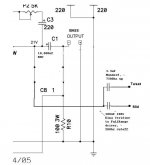
I've got battery of 16 ELNA simlic cap (15x1000UF+220uF) at the output already. And hesitate to do that because of voltage-current phase shift
which was decribed by Vladimirk (above). Does that mean instead of one 1.5uF cap for tweeter I should also use 15x0.1uF to maintain
the same or similar dielectric losses angle ?
- Home
- Amplifiers
- Pass Labs
- F3 Builders Thread
